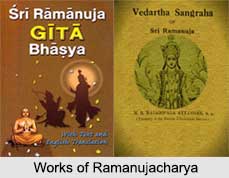 Works of Ramanujacharya are based mostly on his philosophy of Advaita Vedanta. It is believed that he has composed nine monumental works known as "Navaratnas". One of the most monumental works of Ramanujacharya is "Sri Bhasya" which is based on the Vedanta Sutras of Badarayana. His other works are "Vedanta Sangraha", "Vedanta Sara", "Vedanta Deepa", "Gita Bhasya", "Nithya Grantham", "Gadhya Thrayam". Vedanta Sangraha is an independent work that advocates the philosophy of the Upanishads. Vedanta Sara and Vedanta Deepa are brief commentaries on the "Vedanta Sutras". Gita Bhasya is a commentary on the Bhagavad Gita. Nithya Grantham deals with the daily rituals and devotional practices that are meant for his followers. Gadhya Thrayam is a combination of three prose works which are of great religious importance though they are not philosophical in tone.
Works of Ramanujacharya are based mostly on his philosophy of Advaita Vedanta. It is believed that he has composed nine monumental works known as "Navaratnas". One of the most monumental works of Ramanujacharya is "Sri Bhasya" which is based on the Vedanta Sutras of Badarayana. His other works are "Vedanta Sangraha", "Vedanta Sara", "Vedanta Deepa", "Gita Bhasya", "Nithya Grantham", "Gadhya Thrayam". Vedanta Sangraha is an independent work that advocates the philosophy of the Upanishads. Vedanta Sara and Vedanta Deepa are brief commentaries on the "Vedanta Sutras". Gita Bhasya is a commentary on the Bhagavad Gita. Nithya Grantham deals with the daily rituals and devotional practices that are meant for his followers. Gadhya Thrayam is a combination of three prose works which are of great religious importance though they are not philosophical in tone.
Some of the other notable literary works of Ramanujacharya are discussed below:
Ramanujacharya and his disciples visited the Ranganatha Temple in Srirangam on the day of the ascension of the star called Uttiram. He was inspired by the festivities of the day and composed "Sriranga Gadyam" and "Saranagati Gadyam".
Saranagati Gadyam: The first hymn of "Saranagati Gadyam" deals with self-surrender and the way of doing it. Saranagati Gadyam is a pure expression of Bhakti. It describes an imaginary conversation between Ramanujacharya and Narayana. He describes the boundless kindness of Sri and asks that she recommend him to Lord Vishnu. After her approval, he approaches Narayana. He explains the sins committed and is ignorant of philosophy and asks that he be accepted into the group of devotees of Narayana. He asks Narayan to bless him so that he becomes a supreme devotee never forgetting to serve Lord. Lord was pleased and blessed him thereby giving him Moksha.
Sriranga Gadyam: Next one "Sriranga Gadyam", is a prayer to Lord Ranganatha to accept him as his eternal servant. In "Sriranga Gadyam", Lord Ranganatha is described as gyan, power, incomparable untiring manliness, shakthi, agni, purest character, Vaatsalya, kind towards devotees, honesty and many more epithets are added. Thereafter he explains how he is trapped in Samsara and bound by his karma that result in sins. Finally he asks for the grace of Ranganatha.
Vaikuntha Gadyam: The third, "Vaikuntha Gadyam" describes Vaikuntha, Lord Vishnu"s eternal abode. "Vaikunta Gadyam" does not have detailed philosophical theories. It is a pure expression of Bhakti. He stresses the important messages that surrender to Lord Narayana"s feet resulting in attaining the abode of Lord, purity of soul and remaining close to the Lord. Alternate long and short sentence with adjectival phrases is the basic style of this work.
Sri Bhasya: "Sri Bhasya" is a commentary work on Sri Badarayana"s "Vedanta Sutra". It was completed when he was around 100 years old. Here, he presents the fundamental philosophical principles of Visistadvaita that is based on his interpretation of the Upanishads, Bhagavad Gita and other smriti texts, the previous Acharyas and the Vedanta Sutra. This refutes Sankara"s Advaita Vedanta and his Theory of Maya. In this book he describes three categories of reality; God, soul and matter. The principles of Bhakti as a way to liberation were also developed.









